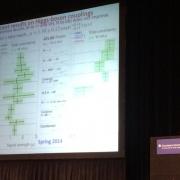Access to Collaboration Site and Physics Results
The High-Luminosity upgrade of the Large Hadron Collider (HL-LHC) is scheduled to begin colliding protons in 2026. This major improvement to CERN’s flagship accelerator will increase the total number of collisions in the ATLAS experiment by a factor of 10. To cope with this increase, ATLAS is preparing a complex series of upgrades including the installation of new detectors using state-of-the-art technology, the replacement of ageing electronics, and the upgrade of its trigger and data acquisition system.
What discovery opportunities will be in reach for ATLAS with the HL-LHC upgrade? How precisely will physicists be able to measure properties of the Higgs boson? How deeply will they be able to probe Standard Model processes for signs of new physics? The ATLAS Collaboration has carried out and released dozens of studies to answer these questions – the results of which have been valuable input to discussions held this week at the Symposium on the European Strategy for Particle Physics, in Granada, Spain.
“Studying the discovery potential of the HL-LHC was a fascinating task associated with the ATLAS upgrades,” says Simone Pagan Griso, ATLAS Upgrade Physics Group co-convener. “The results are informative not only to the ATLAS Collaboration but to the entire global particle-physics community, as they reappraise the opportunities and challenges that lie ahead of us.” Indeed, these studies set important benchmarks for forthcoming generations of particle physics experiments.
Pagan Griso worked with Leandro Nisati, the ATLAS representative on the HL-LHC Physics Potential ‘Yellow Report’ steering committee, and fellow ATLAS Upgrade Physics Group co-convener, Sarah Demers, to coordinate these studies for the collaboration. “A CERN Yellow Report, with publication in its final form forthcoming, will combine ATLAS’ results with those from other LHC experiments, as well as input from theoretical physicists,” says Nisati.
Estimating the performance of a machine that has not yet been built, which will operate under circumstances that have never been confronted, was a complex task for the ATLAS team. “We took two parallel approaches,” explains Demers. “For one set of analysis projections, we began with simulations of the challenging HL-LHC experimental conditions. These simulated physics events were then passed through custom software to show us how the particles would interact with an upgraded ATLAS detector. We then developed new algorithms to try to pick the physics signals from the challenging amount of background events.” Dealing with abundant background will be a common complication for HL-LHC operation.
New studies by the ATLAS Collaboration explore the scientific potential of the High-Luminosity LHC, setting important benchmarks for forthcoming generations of particle physics experiments.

Following this approach, the team found that the HL-LHC dataset will allow ATLAS to hunt for new massive Z bosons (denoted Z’) as heavy as 6.5 TeV, and search for new W’ bosons up to 7.9 TeV mass. “This method was useful in that it taught us about the potential physics reach of the upgraded ATLAS detector, but it also had its limitations,” says Demers. “Our experience has proven that, as we gain familiarity with the operation of the detector and accelerator, we are able to improve our data-taking techniques and have new ideas for physics analyses. It is difficult to quantify how much improvement a decade of thinking and working hard will bring!”
The second approach used in the HL-LHC physics projections utilised ATLAS’ best current physics results. The team considered which components of the analyses were expected to improve, degrade or stay the same under the new HL-LHC conditions. The rich panorama of Higgs boson physics was of significant focus, as its study is amongst the primary targets of the HL-LHC upgrade. The large dataset expected from the HL-LHC will be essential to uncovering many of the unknowns of the Higgs boson.
“Utilising current ATLAS physics results, we projected uncertainties under 5% on measurements of the rates of five types of Higgs boson decays: to b quarks, to taus, to W bosons, to Z bosons and to photons,” says Pagan Griso. “According to these projections, we will also be highly sensitive to rare decays of the Higgs boson, such as its decay to muons.”
This second method benefitted from the full sophistication and optimisation of ATLAS’ current analyses. However, unlike the first approach, it could not directly consider the improvements that the upgraded ATLAS detector will bring. Nor can it fully estimate how much more difficult physics analysis will become under the extreme conditions of the HL-LHC. As such, a combination of the two approaches gives the best possible prediction of ATLAS’ physics potential at the HL-LHC.
Over the course of this study, ATLAS has published over 40 public notes documenting results from over 80 analysis channels. These results are all publicly available and will inform prioritisation strategies for physicists around the world. “These studies represent our best understanding of the tremendous physics potential awaiting ATLAS,” concludes Demers. “It’s exciting to have such opportunities ahead of us, as we continue to learn from the current LHC dataset and work to maximise the information about our Universe that ATLAS can provide.”
Learn more
- Explore the full collection of public notes by the ATLAS and CMS Collaborations: Report on the Physics at the HL-LHC and Perspectives for the HE-LHC
- CERN Courier article: Report reveals full reach of LHC programme









